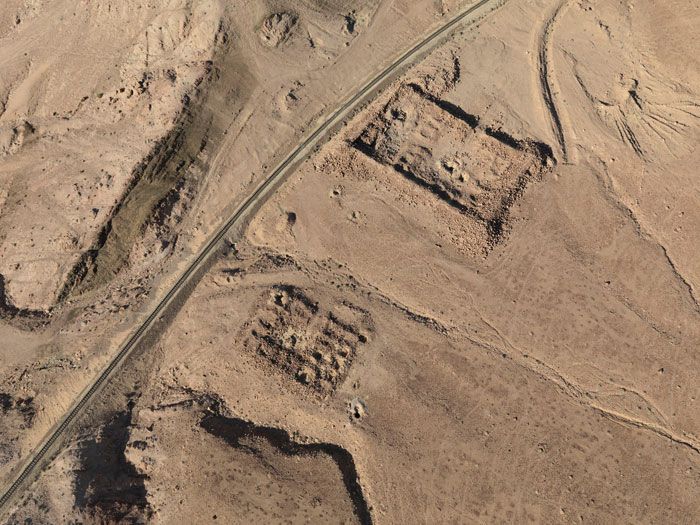Who's in town?
Jananne Al-Ani
Salt Beyoğlu
January 20, 2012 18.30

Still from Shadow Sites I
Since 2007, Jananne Al-Ani has been developing a new body of work titled The Aesthetics of Disappearance: A Land Without People, which explores the disappearance of the body in the contested and highly charged landscapes of the Middle East. The project includes the single screen films Shadow Sites I (2010) and Shadow Sites II (2011).
Frequently depicted as a desert, an exotic place with no history and no population, the Middle Eastern landscape has become familiar to Westerners as the blank backdrop to military action. In response to the use of aerial reconnaissance and satellite navigation devices in the 1991 Desert Storm campaign and the 2003 Gulf War, Al-Ani’s films adopt the vantage point of such missions while taking an altogether different viewpoint of the land surveyed. Scanning the surface or burrowing into the earth, the films excavate what cannot otherwise be seen on the ground. Landscapes disappear and reappear as one image slowly dissolves into another, like a mineshaft tunneling deep into a substrate of memories preserved over time.
The talk by Al-Ani in the Walk-in Cinema and screening of Shadow Sites I, to be shown in the SALT Galata Auditorium on a loop between January 19 and 22, are the first in a series of events to expand on the ideas and content of the exhibition Scramble for the Past: A Story of Archaeology in the Ottoman Empire, 1753-1914. Shadow Sites I was shot in Jordan on 16mm film and is made up of a composition of vertical aerial shots of landscapes ranging from the ancient to the contemporary, exposing archaeological sites as well as marks on the surface of the earth caused by more recent activities such as industrial farming, mining and military training grounds.
Jananne Al-Ani was born in Kirkuk, Iraq in 1966. She studied fine art at the Byam Shaw School of Art and graduated with an MA in Photography from the Royal College of Art. She has had solo shows at Darat al Funun, Amman; Art Now (Tate Britain); and the Imperial War Museum, London. She is the recipient of the Abraaj Capital Art Prize (2011) and the East International Award. She lives and works in London.
The talk will be held in English.
In collaboration with the British Council.
Frequently depicted as a desert, an exotic place with no history and no population, the Middle Eastern landscape has become familiar to Westerners as the blank backdrop to military action. In response to the use of aerial reconnaissance and satellite navigation devices in the 1991 Desert Storm campaign and the 2003 Gulf War, Al-Ani’s films adopt the vantage point of such missions while taking an altogether different viewpoint of the land surveyed. Scanning the surface or burrowing into the earth, the films excavate what cannot otherwise be seen on the ground. Landscapes disappear and reappear as one image slowly dissolves into another, like a mineshaft tunneling deep into a substrate of memories preserved over time.
The talk by Al-Ani in the Walk-in Cinema and screening of Shadow Sites I, to be shown in the SALT Galata Auditorium on a loop between January 19 and 22, are the first in a series of events to expand on the ideas and content of the exhibition Scramble for the Past: A Story of Archaeology in the Ottoman Empire, 1753-1914. Shadow Sites I was shot in Jordan on 16mm film and is made up of a composition of vertical aerial shots of landscapes ranging from the ancient to the contemporary, exposing archaeological sites as well as marks on the surface of the earth caused by more recent activities such as industrial farming, mining and military training grounds.
Jananne Al-Ani was born in Kirkuk, Iraq in 1966. She studied fine art at the Byam Shaw School of Art and graduated with an MA in Photography from the Royal College of Art. She has had solo shows at Darat al Funun, Amman; Art Now (Tate Britain); and the Imperial War Museum, London. She is the recipient of the Abraaj Capital Art Prize (2011) and the East International Award. She lives and works in London.
The talk will be held in English.
In collaboration with the British Council.

